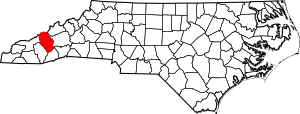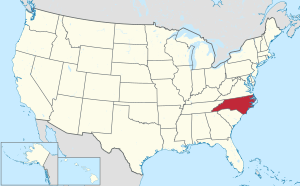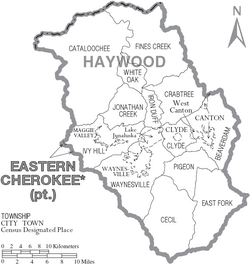Haywood County, North Carolina facts for kids
Quick facts for kids
Haywood County
|
||
|---|---|---|

Haywood County Courthouse
|
||
|
||

Location within the U.S. state of North Carolina
|
||
 North Carolina's location within the U.S. |
||
| Country | ||
| State | ||
| Founded | 1808 | |
| Named for | John Haywood | |
| Seat | Waynesville | |
| Largest community | Waynesville | |
| Area | ||
| • Total | 554.50 sq mi (1,436.1 km2) | |
| • Land | 553.56 sq mi (1,433.7 km2) | |
| • Water | 0.94 sq mi (2.4 km2) 0.17% | |
| Population
(2020)
|
||
| • Total | 62,089 | |
| • Estimate
(2023)
|
62,969 | |
| • Density | 112.16/sq mi (43.31/km2) | |
| Time zone | UTC−5 (Eastern) | |
| • Summer (DST) | UTC−4 (EDT) | |
| Congressional district | 11th | |
Haywood County is a county located in the U.S. state of North Carolina. As of the 2020 census, the population was 62,089. The county seat and its largest community is Waynesville.
Haywood County is part of the Waynesville, NC Micropolitan Statistical Area.
Contents
History
The earliest inhabitants of the area eventually comprising Haywood County were Cherokee Native Americans. Their local population was severely impacted by a smallpox outbreak in 1715. In July 1776, during the early stages of the American Revolutionary War, Cherokee warriors began attacking white settlements in western North Carolina. In response, a militia led by General Griffith Rutherford led an expedition through the region and destroyed dozens of Cherokee villages. White settlement increased after the war, with most of the settlers being of English, Scotch-Irish, German, and Dutch descent. The county was formed in 1808 from the western part of Buncombe County. It was named for John Haywood, who served as the North Carolina State Treasurer from 1787 to 1827. The county seat was designated at Mount Pleasant, which was renamed Waynesville in 1811. The first county courthouse was completed the following year. In 1828, a part of Haywood County was split off and made Macon County. In 1851, parts of Haywood and Macon counties were combined to form Jackson County.
The last shot of the Civil War east of the Mississippi was fired in Waynesville on May 9, 1865, when elements of the Thomas Legion (Confederate) skirmished with the 2nd North Carolina Mounted Infantry (Union). In the 1880s, the Western North Carolina Railroad extended lines through the county, creating new economic industries centered on logging and tourism.
Geography
According to the U.S. Census Bureau, the county has a total area of 554.5 square miles (1,436 km2), of which 553.56 square miles (1,433.7 km2) is land and 0.94 square miles (2.4 km2) (0.17%) is water. It is bordered by Madison, Buncombe, Henderson, Transylvania, Jackson, Swain counties in North Carolina, and Cocke and Sevier counties in Tennessee.
Haywood County lies within the French Broad River basin. Since the county's borders follow mountain ridgelines, all water in the county derives from rain fallen over it or from local springs, with no external watercourses crossing its boundaries. The Pigeon River originates in Haywood County.
Haywood County is situated amidst the Blue Ridge Mountains and contains parts of several major subranges of the Blue Ridge, namely the Great Smoky Mountains in the west and the Plott Balsams and Great Balsam Mountains in the south. Notable peaks in the county include Cold Mountain, at 6,030 feet (1,840 m), Mount Sterling, at 5,835 feet (1,779 m), and Richland Balsam, at 6,410 feet (1,950 m) in elevation. Mt. Guyot, the county's highest point at 6,621 feet (2,018 m), is the 4th highest mountain east of the Mississippi River. Black Balsam Knob, in the Great Balsam Mountains in the southeastern section of the county, is the highest grassy bald in the entire Appalachian range. Haywood County is believed to be the highest county (by mean elevation) east of the Mississippi River, with a mean elevation of 3,597 feet or 1,096 metres. About 40 percent of the county's land lies within the Great Smoky Mountains National Park and the Pisgah National Forest.
National protected areas
- Blue Ridge Parkway (part)
- Middle Prong Wilderness
- Mount Pisgah (part)
- Nantahala National Forest (part)
- Pisgah National Forest (part)
- Shining Rock Wilderness
- Waterrock Knob (part)
State and local protected areas
- Cold Mountain Game Land
- Harmon Den Wildlife Management Area (part)
- Nantahala National Forest Game Land (part)
- Pisgah National Forest Game Land (part)
- Pisgah View State Park (part)
- William H. Silver Game Land (part)
Major water bodies
- Bald Creek
- Big Creek
- Cataloochee Creek
- Cooks Creek
- Cove Creek
- Crabtree Creek
- Jonathans Creek
- Fines Creek
- Lake Junaluska
- Lake Logan
- Laurel Creek
- Little Creek
- Pigeon River
- Richland Creek
- Rocky Branch Lake
- Waterville Lake
Demographics
| Historical population | |||
|---|---|---|---|
| Census | Pop. | %± | |
| 1810 | 2,780 | — | |
| 1820 | 4,073 | 46.5% | |
| 1830 | 4,578 | 12.4% | |
| 1840 | 4,975 | 8.7% | |
| 1850 | 7,074 | 42.2% | |
| 1860 | 5,801 | −18.0% | |
| 1870 | 7,921 | 36.5% | |
| 1880 | 10,271 | 29.7% | |
| 1890 | 13,346 | 29.9% | |
| 1900 | 16,222 | 21.5% | |
| 1910 | 21,020 | 29.6% | |
| 1920 | 23,496 | 11.8% | |
| 1930 | 28,273 | 20.3% | |
| 1940 | 34,804 | 23.1% | |
| 1950 | 37,631 | 8.1% | |
| 1960 | 39,711 | 5.5% | |
| 1970 | 41,710 | 5.0% | |
| 1980 | 46,495 | 11.5% | |
| 1990 | 46,942 | 1.0% | |
| 2000 | 54,033 | 15.1% | |
| 2010 | 59,036 | 9.3% | |
| 2020 | 62,089 | 5.2% | |
| 2023 (est.) | 62,969 | 6.7% | |
| U.S. Decennial Census 1790–1960 1900–1990 1990–2000 2010 2020 |
|||
2020 census
| Race | Number | Percentage |
|---|---|---|
| White (non-Hispanic) | 55,685 | 89.69% |
| Black or African American (non-Hispanic) | 656 | 1.06% |
| Native American | 308 | 0.5% |
| Asian | 360 | 0.58% |
| Pacific Islander | 1 | 0.0% |
| Other/Mixed | 2,250 | 3.62% |
| Hispanic or Latino | 2,829 | 4.56% |
As of the 2020 census, there were 62,089 people, 26,653 households, and 17,170 families residing in the county.
Economy
Pactiv Evergreen is largest employer in Haywood County, and operates a large paper mill in Canton and another facility in Waynesville. In March 2023, the company announced it would close the Canton mill by the end of June. The closure is projected to result in the loss of hundreds of jobs and $500 million in overall economic impact, and Haywood County Schools is expected to become the largest employer.
Transportation
The Blue Ridge Southern Railroad operates a rail line with freight service through Haywood County.
Major highways
 I-40
I-40 US 19
US 19
 US 19 Truck
US 19 Truck US 23
US 23
 US 23 Bus.
US 23 Bus.
 US 64 Truck
US 64 Truck US 74
US 74 US 276
US 276 NC 110
NC 110 NC 209
NC 209 NC 215
NC 215
Education
Haywood County Schools operates 15 schools: an early college (Haywood Early College High School), three high schools (Tuscola, Pisgah, and Central Haywood), three middle schools, eight elementary schools. The districts has no low-performing schools and had the seventh highest combined test results among school districts in the state in 2021–22. The county also hosts Haywood Community College. According to the 2021 American Community Survey, an estimated 27.7 percent of county residents have attained a bachelor's degree or higher level of education.
Culture
Tuscola–Pisgah rivalry
Two county high schools' football teams, the Tuscola High School Mountaineers of Waynesville and Pisgah High School Black Bears of Canton, have maintained a rivalry dating back to the school teams' predecessors' first game in 1922. Annual football games between the two teams are popular events for locals and sometimes attract over 10,000 spectators.
Festivals
Since the 1930s, Haywood County has hosted an annual ramp (Allium tricoccum) convention.
Folkmoot USA is an international folk festival held since 1984 in Waynesville, North Carolina and surrounding communities. During its history, the two-week event has featured around 200 groups from approximately 100 countries. The Southeast Tourism Society has named Folkmoot USA one of its top twenty events for 20 years. The North Carolina General Assembly declared Folkmoot USA to be the state's official international folk festival in 2003.
Communities
Towns
- Waynesville (county seat and largest community)
- Canton
- Clyde
- Maggie Valley
Census-designated places
Unincorporated communities
Townships
Haywood County townships include:
- Beaverdam
- Cataloochee
- Cecil
- Clyde
- Crabtree
- East Fork
- Fines Creek
- Iron Duff
- Ivy Hill
- Jonathan Creek
- Pigeon
- Suttontown
- Waynesville
- White Oak
See also
 In Spanish: Condado de Haywood (Carolina del Norte) para niños
In Spanish: Condado de Haywood (Carolina del Norte) para niños




